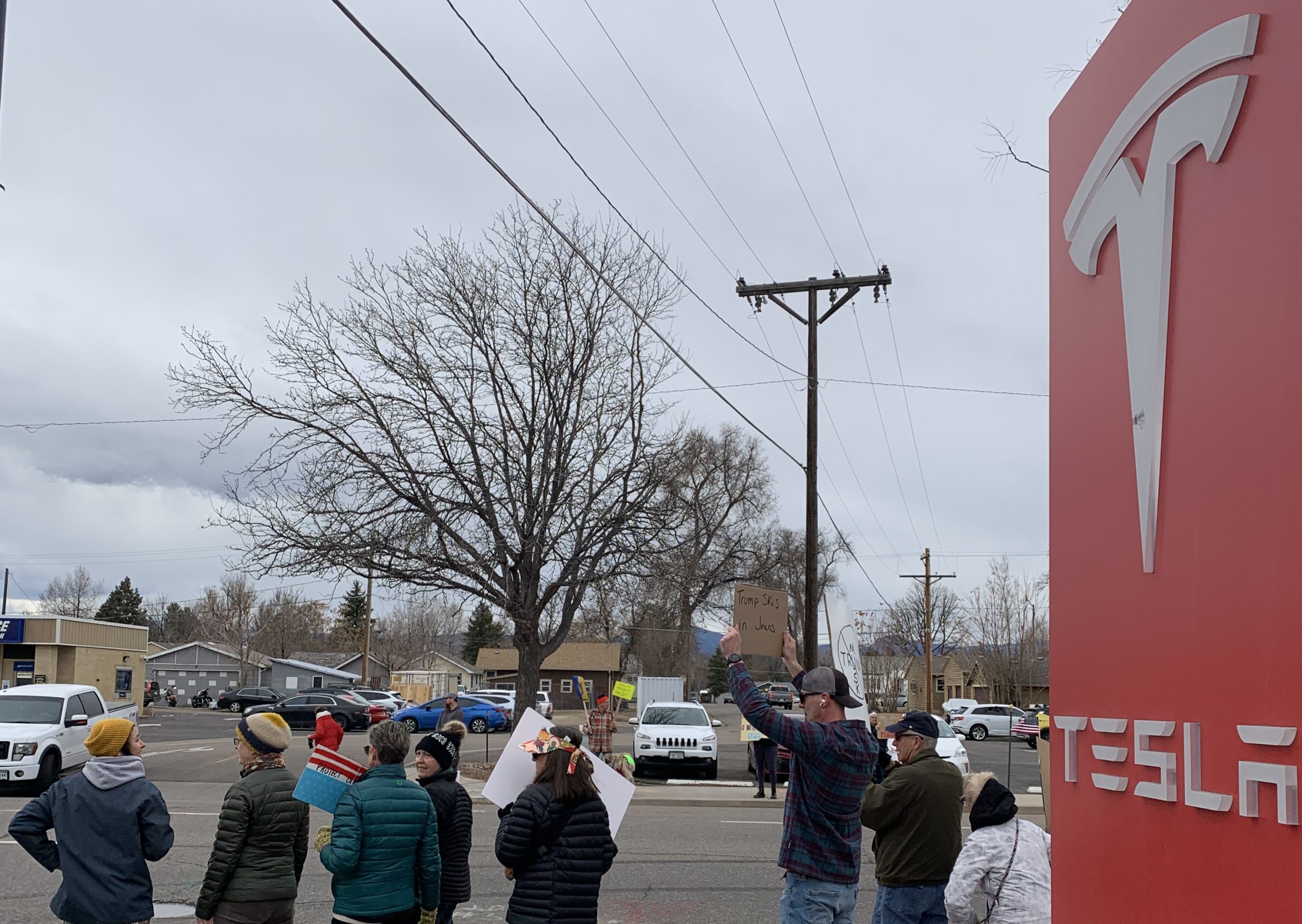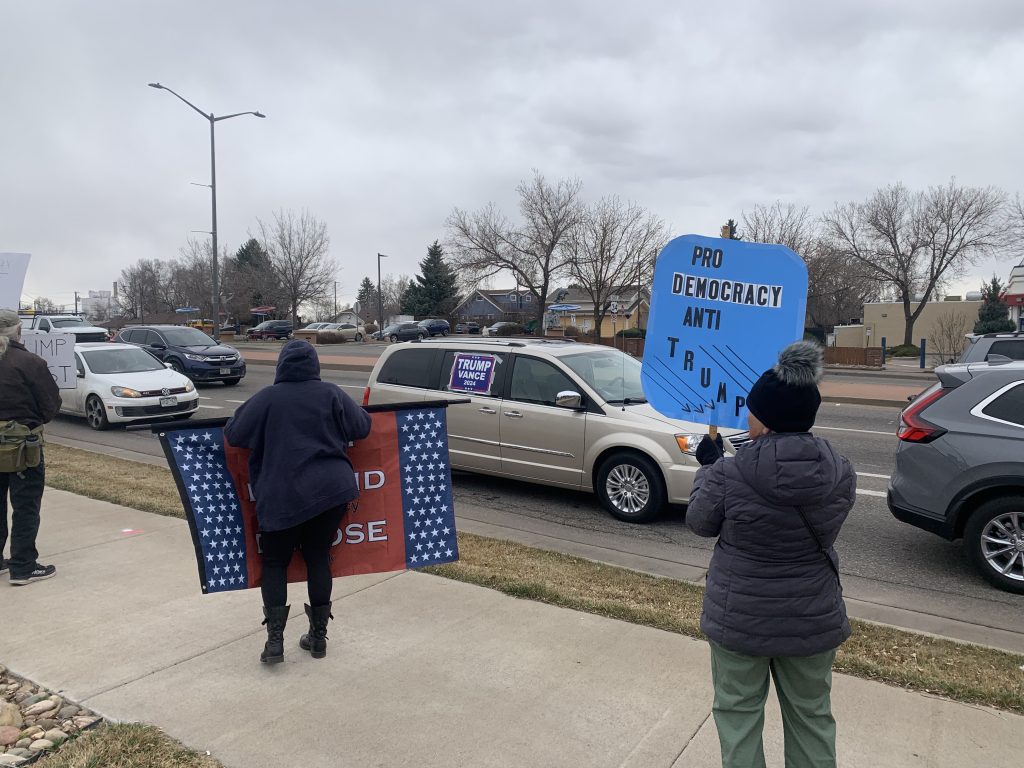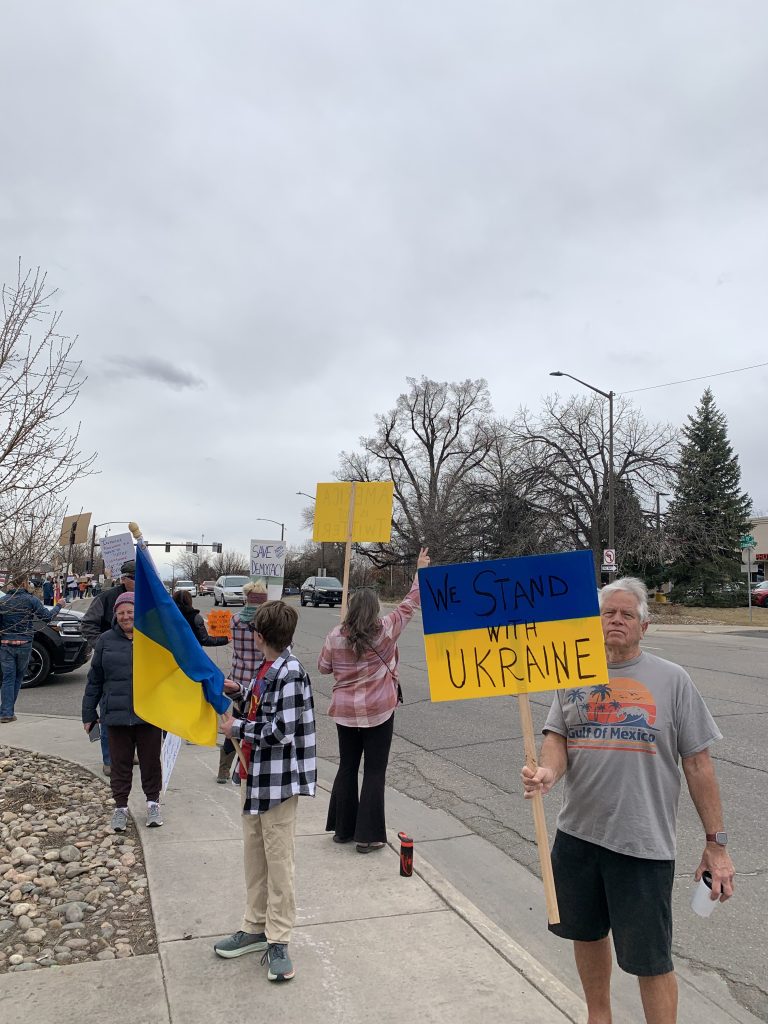News
Tesla stores continue to face anti-Musk protests
Scenes from a protest outside of Tesla’s store in Loveland, Colorado.

Tesla stores have been the target of widespread protests and vandalism in recent weeks, after Elon Musk made a controversial gesture in January, and as he and the Trump administration’s newly created government efficiency division continues to gut federal agencies.
On Saturday, I went to the Tesla store in Loveland, Colorado, where demonstrators were already protesting upon my arrival at roughly 12:45 p.m. MT. Walking up to the protest, I could see scattered groups of demonstrators lined up along about two blocks, spanning from the Tesla store to a nearby intersection and Sprouts location. One protestor said he had counted about 230 people at around 1:00 p.m. MT.
The protest felt generally peaceful, with cars driving by and honking, and demonstrators leaving a large space between the front of the Tesla store and the sidewalk, easily allowing workers and customers to go in and out.
You can see a few videos and photos from the site below, along with some of the responses I got from protestors and a prospective customer.
Walking up to the protest, I could see scattered groups of demonstrators lined up along about two blocks, spanning from the Tesla store to a nearby intersection and Sprouts location.
One protestor said he had counted about 230 people at around 1:00 p.m. MT. pic.twitter.com/gbZIuWWej7
— TESLARATI (@Teslarati) March 15, 2025
Protests in front of the Tesla store in Loveland, Colorado pic.twitter.com/qLRM9TY0ng
— TESLARATI (@Teslarati) March 15, 2025




READ MORE ON TESLA PROTESTS AND VANDALISM:
- U.S. AG Pam Bondi: Tesla Molotov attack suspect facing up to 20 years in prison
- Tesla mulls adding a new feature to fight off vandals as anti-Musk protests increase
- Tesla fire in Germany may be considered a threat to the state
- Tesla showroom in Oregon gets shot up for second time in a week
- Donald Trump pledges Tesla purchase amid anti-Musk protests
- Congress supports probe into ‘domestic terrorism’ of Tesla vandalism
- Anti-Musk protests at Tesla store in New York lead to arrests
- Elon Musk slams MSNBC for relating Trump’s terrorism warning to Tesla ‘protests’
- One dozen Teslas burn in arson attack in France, investigation underway
I spoke to about a dozen protestors about what they were protesting against. Most said they were there to condemn Musk’s recent federal worker and program cuts with the Trump administration, his performance of what some said resembled a Nazi salute at Trump’s inauguration ceremony in January, or the administration’s recent attacks against transgender and queer individuals.
One protestor, Elsa, identified as a former Republican and said she was “highly concerned that our Constitution is being ignored,” especially with regards to the three branches of government and the system of checks and balances.
“It surprises me that, even if you voted for Trump, or you believe in capitalism, which, I didn’t vote for Trump, but I do believe in capitalism — I’m a former Republican, I was a Republican for most of my life — but it’s dangerous to have power rest in a handful of ultra-wealthy people,” Elsa said.
“And our whole country needs to realize that,” she adds. “This to me is not even Republican or Democrat at this point.”
Instead, she says it now comes down to whether people want to give billionaires huge tax breaks, or to use that money to support a range of groups in the U.S., including those who have social security benefits, are veterans, or are 9/11 survivors seeking cancer treatments, as a few examples.
Another protestor, Mary, said she was taking part in the demonstration “because she loves this country and democracy,” adding that she wanted to help preserve democracy for her grandchildren.
Still another protestor, Bryan, said that they were protesting because of the Trump administration and Musk’s attempts to erase transgender, non-binary, and queer people from history, drawing comparisons to the rise of fascism in Nazi Germany, where early human rights violations were lodged against gay and queer communities.
“I’m here because I have to be,” Bryan said. “I’m afraid of the future.”
Yet another person and his family were holding Ukraine flags, saying that they were protesting for a wide range of reasons, but especially for Trump’s recent meeting with Ukraine President Volodymyr Zelenskyy and Musk’s claims that the top Ukrainian executive was to blame for what he has called a “forever war.”
While most protestors appeared to be generally friendly, especially with each other, I did hear a few exchanges between demonstrators and those with other opinions. While I heard more cars honking throughout the experience, seemingly in support of the protests, I also noticed a few from which passengers yelled things like “Go Trump.”
“Direct action, we need to stop these fascists with direct action,” one protestor yelled in response.
Additionally, I also talked to a prospective customer, Kristy, who was there for a test drive and said she had a negative experience with the protestors.
“I was test driving a Tesla, and as we pulled in and parked right here, this black one, these people right here in the middle yelled at me, ‘Hope you’re turning in your f*cking Nazi car,’ and I said ‘F*ck you,’” Kristy explained.
“And they’re like ‘F*ck you too, you’re a Nazi, f*cking Nazi lovers.’ And so, they’re just yelling racial slurs at me, and I’m far from a Nazi.”
Tesla store advisers declined to comment on the protests, and so did Loveland police.
Other Saturday protest footage from Tesla stores in California, Texas, and New York
The Loveland Tesla store has also been the site of repeated attacks in recent weeks, with authorities on Friday making a second arrest following multiple incidents. You can see the Department’s press release for the arrest below.
Another arrest has been made by the Loveland Police Department.🚔
The arrest was related to an incident earlier this month, which involved an incendiary device being ignited and thrown at a Tesla location. https://t.co/s1pZjAacD3
— TESLARATI (@Teslarati) March 14, 2025
The protest was also part of widespread demonstrations on Saturday, and it’s just the latest in actions targeting Musk’s electric vehicle (EV) company, some of which have included acts of vandalism, graffiti, arson, and even the use of weapons on Tesla storefronts.
Multiple other protests were also captured in footage on Saturday, including one in Santa Rosa, California, as shared by the San Francisco Chronicle, and another attended by conspiracy theorist Alex Jones in Austin, Texas. Still another was captured in New York City, and you can see footage from each of these protests below.
“Hey, hey, ho, ho, Elon Musk has got to go.”
Protesters rally during a protest outside a Tesla showroom against U.S. President Donald Trump and the Tesla CEO in Santa Rosa. 🎥: @stephenlamphoto pic.twitter.com/qpXuuGNghf
— San Francisco Chronicle (@sfchronicle) March 15, 2025
Viciously crazed leftist Tesla protesters in Austin are dumbstruck when I invoke the truth about their movement, calling it a “Pedophile Satan Cult”. pic.twitter.com/WzWPfYup4R
— Alex Jones (@RealAlexJones) March 15, 2025
Another anti-Elon Musk and Tesla protest outside of a showroom in New York City! pic.twitter.com/QLrRfWesG2
— Art Candee 🍿🥤 (@ArtCandee) March 15, 2025

Elon Musk
Elon Musk and Tesla AI Director share insights after empty driver seat Robotaxi rides
The executives’ unoccupied tests hint at the rapid progress of Tesla’s unsupervised Robotaxi efforts.

Tesla CEO Elon Musk and AI Director Ashok Elluswamy celebrated Christmas Eve by sharing personal experiences with Robotaxi vehicles that had no safety monitor or occupant in the driver’s seat. Musk described the system’s “perfect driving” around Austin, while Elluswamy posted video from the back seat, calling it “an amazing experience.”
The executives’ unoccupied tests hint at the rapid progress of Tesla’s unsupervised Robotaxi efforts.
Elon and Ashok’s firsthand Robotaxi insights
Prior to Musk and the Tesla AI Director’s posts, sightings of unmanned Teslas navigating public roads were widely shared on social media. One such vehicle was spotted in Austin, Texas, which Elon Musk acknowleged by stating that “Testing is underway with no occupants in the car.”
Based on his Christmas Eve post, Musk seemed to have tested an unmanned Tesla himself. “A Tesla with no safety monitor in the car and me sitting in the passenger seat took me all around Austin on Sunday with perfect driving,” Musk wrote in his post.
Elluswamy responded with a 2-minute video showing himself in the rear of an unmanned Tesla. The video featured the vehicle’s empty front seats, as well as its smooth handling through real-world traffic. He captioned his video with the words, “It’s an amazing experience!”
Towards Unsupervised operations
During an xAI Hackathon earlier this month, Elon Musk mentioned that Tesla owed be removing Safety Monitors from its Robotaxis in Austin in just three weeks. “Unsupervised is pretty much solved at this point. So there will be Tesla Robotaxis operating in Austin with no one in them. Not even anyone in the passenger seat in about three weeks,” he said. Musk echoed similar estimates at the 2025 Annual Shareholder Meeting and the Q3 2025 earnings call.
Considering the insights that were posted Musk and Elluswamy, it does appear that Tesla is working hard towards operating its Robotaxis with no safety monitors. This is quite impressive considering that the service was launched just earlier this year.
Elon Musk
Starlink passes 9 million active customers just weeks after hitting 8 million
The milestone highlights the accelerating growth of Starlink, which has now been adding over 20,000 new users per day.

SpaceX’s Starlink satellite internet service has continued its rapid global expansion, surpassing 9 million active customers just weeks after crossing the 8 million mark.
The milestone highlights the accelerating growth of Starlink, which has now been adding over 20,000 new users per day.
9 million customers
In a post on X, SpaceX stated that Starlink now serves over 9 million active users across 155 countries, territories, and markets. The company reached 8 million customers in early November, meaning it added roughly 1 million subscribers in under seven weeks, or about 21,275 new users on average per day.
“Starlink is connecting more than 9M active customers with high-speed internet across 155 countries, territories, and many other markets,” Starlink wrote in a post on its official X account. SpaceX President Gwynne Shotwell also celebrated the milestone on X. “A huge thank you to all of our customers and congrats to the Starlink team for such an incredible product,” she wrote.
That growth rate reflects both rising demand for broadband in underserved regions and Starlink’s expanding satellite constellation, which now includes more than 9,000 low-Earth-orbit satellites designed to deliver high-speed, low-latency internet worldwide.
Starlink’s momentum
Starlink’s momentum has been building up. SpaceX reported 4.6 million Starlink customers in December 2024, followed by 7 million by August 2025, and 8 million customers in November. Independent data also suggests Starlink usage is rising sharply, with Cloudflare reporting that global web traffic from Starlink users more than doubled in 2025, as noted in an Insider report.
Starlink’s momentum is increasingly tied to SpaceX’s broader financial outlook. Elon Musk has said the satellite network is “by far” the company’s largest revenue driver, and reports suggest SpaceX may be positioning itself for an initial public offering as soon as next year, with valuations estimated as high as $1.5 trillion. Musk has also suggested in the past that Starlink could have its own IPO in the future.
News
NVIDIA Director of Robotics: Tesla FSD v14 is the first AI to pass the “Physical Turing Test”
After testing FSD v14, Fan stated that his experience with FSD felt magical at first, but it soon started to feel like a routine.

NVIDIA Director of Robotics Jim Fan has praised Tesla’s Full Self-Driving (Supervised) v14 as the first AI to pass what he described as a “Physical Turing Test.”
After testing FSD v14, Fan stated that his experience with FSD felt magical at first, but it soon started to feel like a routine. And just like smartphones today, removing it now would “actively hurt.”
Jim Fan’s hands-on FSD v14 impressions
Fan, a leading researcher in embodied AI who is currently solving Physical AI at NVIDIA and spearheading the company’s Project GR00T initiative, noted that he actually was late to the Tesla game. He was, however, one of the first to try out FSD v14.
“I was very late to own a Tesla but among the earliest to try out FSD v14. It’s perhaps the first time I experience an AI that passes the Physical Turing Test: after a long day at work, you press a button, lay back, and couldn’t tell if a neural net or a human drove you home,” Fan wrote in a post on X.
Fan added: “Despite knowing exactly how robot learning works, I still find it magical watching the steering wheel turn by itself. First it feels surreal, next it becomes routine. Then, like the smartphone, taking it away actively hurts. This is how humanity gets rewired and glued to god-like technologies.”
The Physical Turing Test
The original Turing Test was conceived by Alan Turing in 1950, and it was aimed at determining if a machine could exhibit behavior that is equivalent to or indistinguishable from a human. By focusing on text-based conversations, the original Turing Test set a high bar for natural language processing and machine learning.
This test has been passed by today’s large language models. However, the capability to converse in a humanlike manner is a completely different challenge from performing real-world problem-solving or physical interactions. Thus, Fan introduced the Physical Turing Test, which challenges AI systems to demonstrate intelligence through physical actions.
Based on Fan’s comments, Tesla has demonstrated these intelligent physical actions with FSD v14. Elon Musk agreed with the NVIDIA executive, stating in a post on X that with FSD v14, “you can sense the sentience maturing.” Musk also praised Tesla AI, calling it the best “real-world AI” today.








